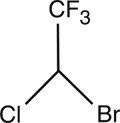Halothane
Dosage form: inhalant
Drug class:General anesthetics
Medically reviewed by Drugs.com. Last updated on Mar 22, 2022.
INHALATION ANESTHETIC
Protect from light.
Rx only

On This Page
Halothane Description
Halothane, USP is an inhalation anesthetic chemically designated 2-bromo-2-chloro-1,1,1-trifluoroethane. The specific gravity is 1.872 to 1.877 at 20° C, and the boiling point (range) is 49° to 51° C, at 760 mm Hg. The vapor pressure is 243 mm Hg at 20° C. The blood/gas coefficient is 2.5 at 37° C, and the olive oil/water coefficient is 220 at 37° C. Vapor concentrations within anesthetic range are nonirritating and have a pleasant odor. Halothane is nonflammable, and its vapors mixed with oxygen in proportions from 0.5 to 50% (v/v) are not explosive. Halothane has a molecular weight of 197.38 and a chemical formula of C2HBrClF3.
Halothane does not decompose in contact with warm soda lime. When moisture is present, the vapor attacks aluminum, brass and lead, but not copper. Rubber, some plastics, and similar materials are soluble in Halothane; such materials will deteriorate rapidly in contact with Halothane vapor or liquid. Stability of liquid Halothane is maintained by the addition of 0.01% thymol (w/w), and storage is in amber colored bottles.
Halothane should not be kept indefinitely in vaporizer bottles not specifically designed for its use. It is recommended that vaporizers be emptied at the end of each operating day. Thymol, which does not volatilize along with Halothane, accumulates in the vaporizer, and may, in time, impart a yellow color to the remaining liquid or to wicks in vaporizers. The development of such discoloration may be used as an indicator that the vaporizer should be drained and cleaned, and the discolored Halothane discarded. Accumulation of thymol may be removed by washing with diethyl ether. After cleaning a wick or vaporizer, make certain all the diethyl ether has been removed before reusing the equipment to avoid introducing ether into the system.
ACTIONS
Volatilized Halothane, USP acts as an inhalation anesthetic. Induction and recovery are rapid and depth of anesthesia can be rapidly altered. Halothane anesthesia progressively depresses respiration. There may be tachypnea with reduced tidal volume and alveolar ventilation. Halothane vapor is not an irritant to the respiratory tract, and no increase in salivary or bronchial secretions ordinarily occurs. Pharyngeal and laryngeal reflexes are rapidly obtunded. It causes bronchodilation. Hypoxia, acidosis, or apnea may develo...



